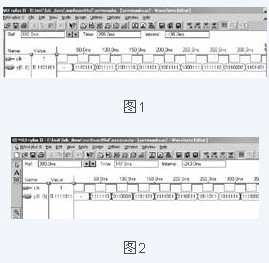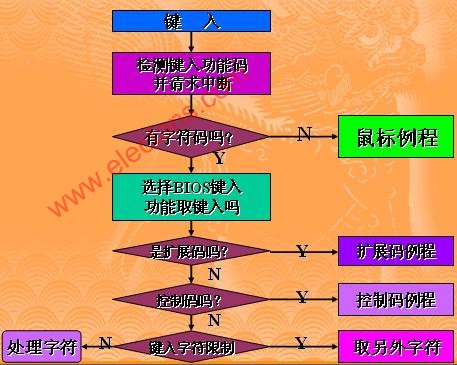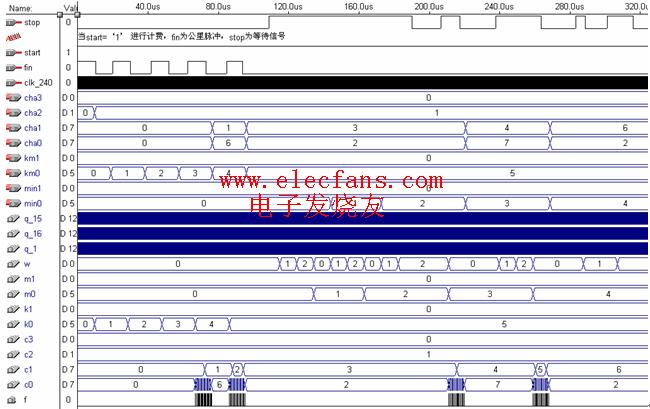蜂鳴器是一種一體化結構的電子訊響器,采用直流電壓供電,廣泛應用于計算機、打印機、復印機、報警器、電子玩具、汽車電子設備、電話機、定時器等電子產品中作發聲器件。蜂鳴器主要分為壓電式蜂鳴器和電磁式蜂鳴器兩種類型。蜂鳴器在電路中用字母“H”或“HA”(舊標準用“FM”、“ZZG”、“LB”、“JD”等)表示。本文為大家介紹基于vhdl蜂鳴器程序設計。
實驗步驟

1、設置端口
1)輸入端口
CLK:40MHZ系統時鐘輸入端口。
2)輸出端口
device:樂曲的聲音輸出端口,輸出的是對應各音符頻率的方波信號。 2、設置模塊 1)自動演奏模塊
自動演奏模塊可以自動播放電子琴內置樂曲,按節拍讀取內置樂譜。將鍵盤輸入的音符信號輸出。因此,本模塊是向Tone模塊提供音符信息。
首先,對40MHz系統時鐘進行10M的分頻,得到4Hz的信號,這樣一秒中就可以按照四拍進行。然后依照此頻率進行地址累計。

音頻發生器模塊
根據自動演奏模塊的信號輸出,不同的信號被翻譯為不同的頻率。

蜂鳴器驅動模塊
根據音頻發生器發出音頻的不同,蜂鳴器得到的驅動也不同。首先,對系統時鐘進行40分頻,再對1mhz的脈沖再次分頻,得到所需要的音符頻率,然后再進行2分頻。

實驗代碼
library ieee;
use ieee.std_logic_1164.all;
use ieee.std_logic_arith.all;
use ieee.std_logic_unsigned.all;
entity tone is port( index: in std_logic_vector(15 downto 0); --音符輸入信號
tone0: out integer range 0 to 2047 --音符的分頻系數 );
end tone;
architecture behavioral of tone is
begin
search :process(index) --此進程完成音符到音符的分頻系數譯碼,音符的顯示,高低音階
begin
case index is
when “0000000000000001” => tone0<=1433;
when “0000000000000010” => tone0<=1277;
when “0000000000000100” => tone0<=1138;
when “0000000000001000” => tone0<=1074;
when “0000000000010000” => tone0<=960;
when “0000000000100000” => tone0<=853;
when “0000000001000000” => tone0<=759;
when “0000000010000000” => tone0<=716;
when “0000000100000000” => tone0<=358;
when “0000001000000000” => tone0<=319;
when “0000010000000000” => tone0<=284;
when “0000100000000000” => tone0<=268;
when “0001000000000000” => tone0<=239;
when “0010000000000000” => tone0<=213;
when “0100000000000000” => tone0<=190;
when “1000000000000000” => tone0<=638;
when others => tone0<=0;
end case;
end process;
end behavioral;
library ieee;
use ieee.std_logic_1164.all;
use ieee.std_logic_arith.all;
use ieee.std_logic_unsigned.all;
entity speaker is port( clk1: in std_logic; --系統時鐘12mhz
tone1: in integer range 0 to 2047; --音符分頻系數
spks: out std_logic --驅動揚聲器的音頻信號 );
end speaker;
architecture behavioral of speaker is
signal preclk, fullspks:std_logic;
begin
p1:process(clk1)--此進程對系統時鐘進行16分頻
variable count: integer range 0 to 16;
begin
if clk1‘event and clk1=’1‘ then count:=count+1;
if count=8 then
preclk<=‘1’;
elsif count=16 then preclk<=‘0’;
count:=0;
end if;
end if;
end process p1;
p2:process(preclk,tone1)--對0.75mhz的脈沖再次分頻,得到所需要的音符頻率
variable count11:integer range 0 to 2047;
begin
if preclk‘event and preclk=’1‘ then
if count11
count11:=count11+1;
fullspks<=’1‘;
else
count11:=0;
fullspks<=’0‘;
end if;
end if;
end process p2;
p3:process(fullspks)--此進程對fullspks進行2分頻
variable count2: std_logic:=’0‘;
begin
if fullspks’event and fullspks=‘1’ then
count2:=not count2;
if count2=‘1’ then
spks<=‘1’;
else spks<=‘0’;
end if;
end if;
end process p3;
end behavioral;
library ieee;
use ieee.std_logic_1164.all;
use ieee.std_logic_arith.all;
use ieee.std_logic_unsigned.all;
entity laohu is port( clk: in std_logic;--系統時鐘;鍵盤輸入/自動演奏
tone_key_0: buffer std_logic_vector(15 downto 0)--音符信號輸出
);
end laohu;
architecture behavioral of laohu is
signal count0:integer range 0 to 31;--change
signal clk2:std_logic;
begin p1:process(clk) --對12mhz系統時鐘進行3m的分頻,得到4hz的信號clk2
variable count:integer range 0 to 3000000;
begin if clk‘event and clk=’1‘ then
count:=count+1;
if count=1500000 then
clk2<=’1‘;
elsif count=3000000 then
clk2<=’0‘;
count:=0;
end if;
end if;
end process p1;
p2:process(clk2)--此進程完成自動演奏部分樂曲的地址累加
begin if clk2’event and clk2=‘1’ then
if count0=29 then
count0<=0;
else count0<=count0+1;
end if;
end if;
end process p2;
p3:process(count0,tone_key_0)
begin
case count0 is--此case語句:存儲自動演奏部分的樂曲
when 0 => tone_key_0<=b“00000001_00000000”; --1
when 1 => tone_key_0<=b“00000010_00000000”; --2
when 2 => tone_key_0<=b“00000100_00000000”; --3
when 3 => tone_key_0<=b“00000001_00000000”; --1
when 4 => tone_key_0<=b“00000001_00000000”; --1
when 5 => tone_key_0<=b“00000010_00000000”; --2
when 6 => tone_key_0<=b“00000100_00000000”; --3
when 7 => tone_key_0<=b“00000001_00000000”; --1
when 8 => tone_key_0<=b“00000100_00000000”; --3
when 9 => tone_key_0<=b“00001000_00000000”; --4
when 10 => tone_key_0<=b“00010000_00000000”; --5
when 11 => tone_key_0<=b“00000100_00000000”; --3
when 12 => tone_key_0<=b“00001000_00000000”; --4
when 13 => tone_key_0<=b“00010000_00000000”; --5
when 14 => tone_key_0<=b“00010000_00000000”; --5
when 15 => tone_key_0<=b“00100000_00000000”; --6
when 16 => tone_key_0<=b“00010000_00000000”; --5
when 17 => tone_key_0<=b“00001000_00000000”; --4
when 18 => tone_key_0<=b“00000100_00000000”; --3
when 19 => tone_key_0<=b“00000001_00000000”; --1
when 20 => tone_key_0<=b“00010000_00000000”; --5
when 21 => tone_key_0<=b“00100000_00000000”; --6
when 22 => tone_key_0<=b“00010000_00000000”; --5
when 23 => tone_key_0<=b“00001000_00000000”; --4
when 24 => tone_key_0<=b“00000100_00000000”; --3
when 25 => tone_key_0<=b“00000001_00000000”; --1
when 26 => tone_key_0<=b“00000100_00000000”; --3
when 27 => tone_key_0<=b“00000000_00100000”; --di6
when 28 => tone_key_0<=b“00000001_00000000”; --1
when others => null;
end case;
end process p3;
end behavioral;
library ieee;
use ieee.std_logic_1164.all;
use ieee.std_logic_arith.all;
use ieee.std_logic_unsigned.all;
entity beep0 is
port( clk:in std_logic; device:out std_logic );
end beep0;
architecture behavioral of beep0 is
component laohu is port( clk: in std_logic;--系統時鐘;鍵盤輸入/自動演奏
tone_key_0: out std_logic_vector(15 downto 0)--音符信號輸出 );
end component;
component tone is
port( index: in std_logic_vector(15 downto 0);--音符輸入信號
tone0: out integer range 0 to 2047--音符的分頻系數 );
end component;
component speaker is
port(
clk1: in std_logic;--系統時鐘12mhz
tone1: in integer range 0 to 2047; --音符分頻系數
spks: out std_logic--驅動揚聲器的音頻信號 );
end component;
signal mid:std_logic_vector(15 downto 0);
signal tones:integer;
begin
u0:laohu port map(clk,mid);
u1:tone port map(mid,tones);
u2:speaker port map(clk,tones,device);
end behavioral;
 電子發燒友App
電子發燒友App


























評論